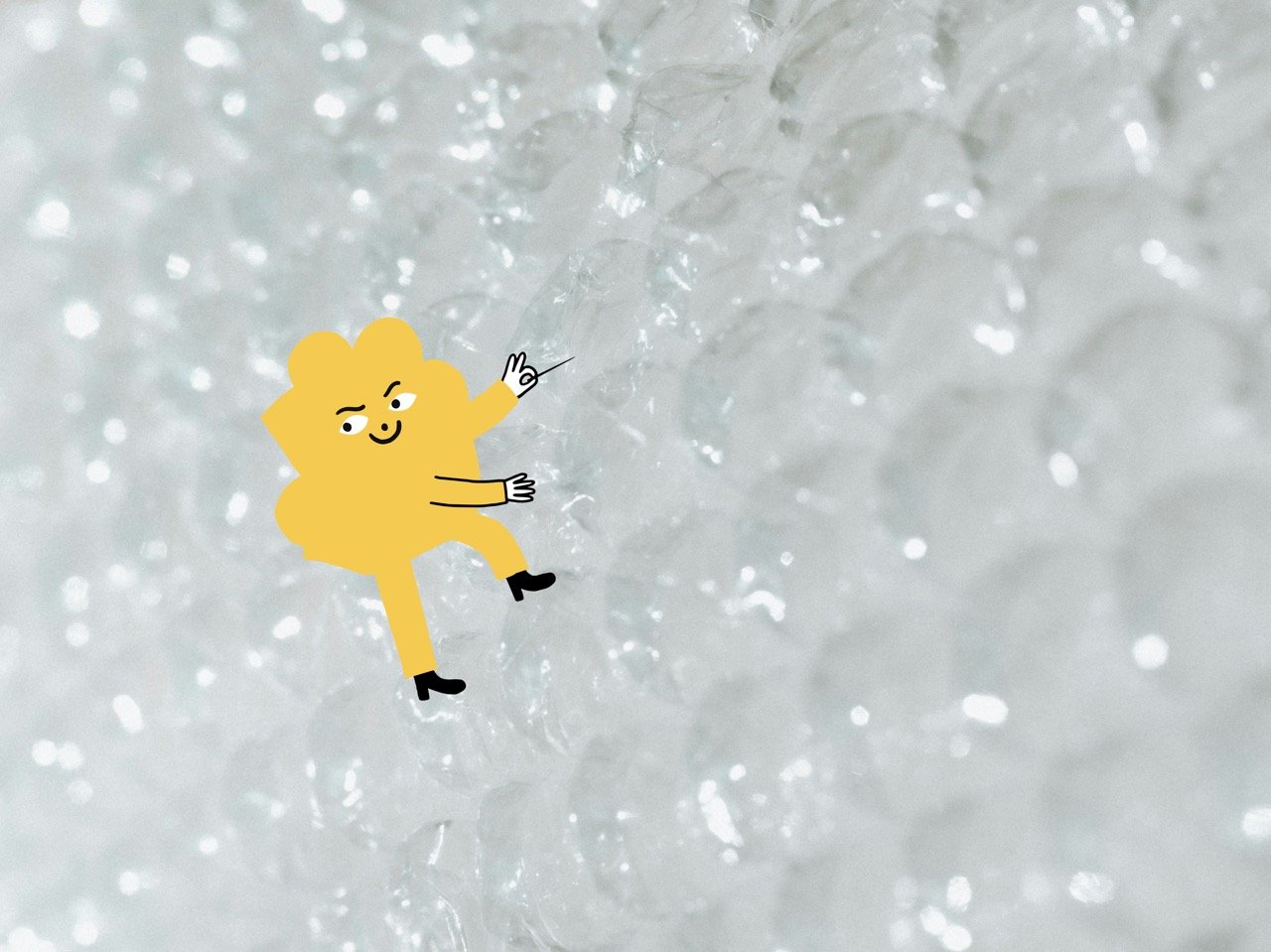From production to popping: how is bubble wrap made?
Born in 1957 as textured wallpaper, bubble wrap has since come to dominate the world of protective packaging. It’s lightweight, dirt-cheap, and versatile as a packaging material — but on the flip side also very polluting, hard to recycle and and not very resusable.
Bubble wrap is made by merging two layers of polyethylene film, from which air bubbles are blown into. It is then sealed, cooled, perforated, and wound into rolls to be used as protective packaging material.
See a quick 5-min video overview of the entire production process and keep reading below for more info:
Despite environmental concerns, bubble wrap’s pop-ularity remains high and it continues to be ever-present wherever packaging, especially ecommerce packaging, is required.
The origins of bubble wrap
How was bubble wrap invented?
It all began in 1957 when engineers Marc Chavannes and Alfred Fielding tried to create textured wallpaper by sealing two shower curtains together and trapping air bubbles between them.
While the wallpaper idea failed, they discovered the potential of their product’s protective cushioning properties. Chavannes and Fielding founded the Sealed Air Corporation three years later in 1960 to further develop their product which became branded as “Bubble Wrap”.
They patented the equipment and process of making bubble wrap and set out to find its uses. While one use - greenhouse insulation - seemed viable, it unfortunately proved ineffective during testing.
How bubble wrap popped into the world
Bubble wrap’s big pop came when Chavannes and Fielding decided to use it as packaging material. In 1961 bubble wrap found its first match with IBM’s 1401 unit. Deemed as the Model T of the computer world, IBM needed a way to transport these fragile, delicate devices safely. As they say, the rest is history.
Before bubble wrap, surrounding items with balled-up newspaper was the standard way of protecting fragile items during shipping. This quickly got messy as the newspaper ink often rubbed off on the items and those who handled them. Worse still, these newspaper balls offered little protection.
As bubble wrap was the opposite with its protective cushioning properties, cleanliness and ease of use, it caught on and bubbled to the forefront of protective packaging.
The main downsides of plastic bubble wrap? Well, there are a few: its production requires burning fossil fuels (which heats the planet) and it’s primarily single-use. Additionally, recycling bubble wrap is not an economically or technically feasible plastic waste management solution.
What is bubble wrap made of?
Pictured: polyethylene resins, a type of thermoplastics that are formed with heat (simply put, by burning petrochemicals) and re-melted as needed to create plastic film
Bubble wrap primarily consists of low-density polyethylene (LDPE), a durable and adaptable plastic. More specifically, it’s made from RIC4, a low-density polyethylene film (LPDF) that can take up to 1000 years to degrade.
Derived from petrochemicals, particularly ethylene (a form of natural gas) and other hydrocarbons, these raw materials are created by burning fossil fuels.
Bubble wrap’s air-filled bubbles, its main distinctive characteristic, are introduced during the manufacturing process. Air is injected into a thin LPDF, creating the bubbles that make the material effective in cushioning and protection. It’s this combination of LDPF and trapped air that defines the composition of bubble wrap.
How exactly is bubble wrap made? A step-by-step look at the production.
Bubble wrap is made through an intricate manufacturing process that involves three key stages: plastic compounding and sheet extrusion, lamination and finishing.
Step 1: Plastic compounding and sheet extrusion
In this foundational step, raw materials, particularly LDPE, undergo a precise compounding process and are blended to achieve the desired properties of flexibility and durability.
The compounded mixture is then fed into an extruder, where heat and pressure form it into two sheets of clear plastic film: one being the layer that forms the backing and the other being the layer that forms the bubbles.
You can read more about plastic extrusion process here, if you’d like.
Step 2: Lamination
This crucial lamination phase involves suctioning, air introduction, and sealing.
Initially, one plastic sheet is suctioned into bubble-shaped moulds through a specialised machine, forming the iconic half-sphere bubbles.
The second plastic sheet is then introduced, playing a dual role in creating air pockets. Utilising a vacuum sealing mechanism, the bubbles are filled with air and securely trapped between the two layers.
The final touch involves sealing the bubbles. Through a carefully calibrated heat and pressure process, the bubbles are sealed to ensure that the air is securely trapped.
Step 3: Finishing
Finally, in the finishing stage, quality control measures are implemented and additional treatments may be applied to enhance its performance, for example, anti-static or anti-abrasion coatings.
The bubble wrap is then rolled or cut into the required sizes and shapes before being packed and stored, ready for its use in packaging.
The environmental impact of bubble wrap
Bubble wrap’s journey from accidental discovery to widely-used packaging material is one for the (history) books. Today, we know better – that we need to do better than using single-use plastics like bubble wrap if we want to keep our planet liveable.
Today, the packaging industry is still the biggest consumer of plastic as well as the biggest polluter. And the demand is expected to only grow.
While all packaging has some impact, plenty of sustainable bubble wrap alternatives exist! Opt for packaging that’s reusable, recyclable and made of zero fossil-fuel-based materials to make your packaging lighter on the planet than plastic.
P.S. If you’re a business that’s keen on exploring sustainable packaging that’s protective, you can request free Woola packaging samples here.




